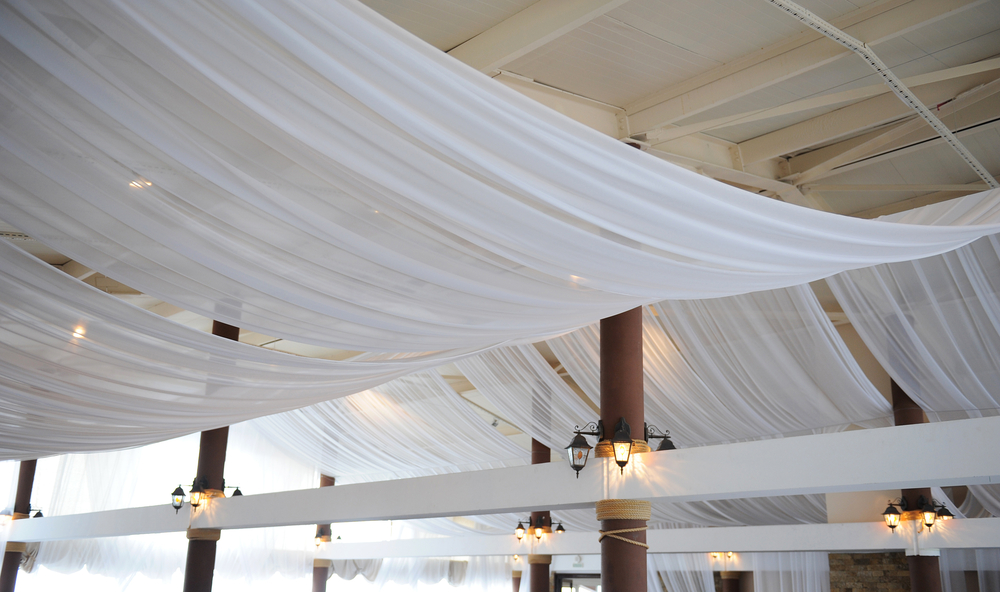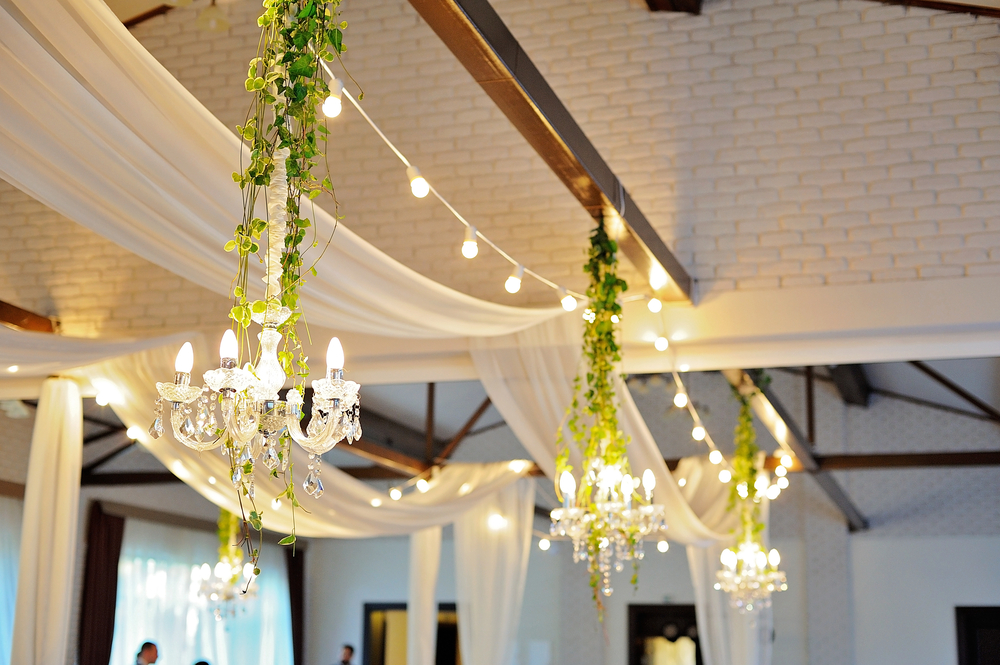Looking to host a once-in-a-lifetime event? You’ll need to pay attention to your decor. More importantly, you’ll need to figure out decor to transform your space and bring guests into another dimension. There’s no better way to accomplish this grand feat than through ceiling drape.
Ceiling drape are pretty simple—they’re long pieces of fabric that hang down from the ceiling. However, the specifics of ceiling drape can get complicated—you’ll need to determine the right color and material and how much you’ll need. If you want to do a DIY ceiling drape, you’ll also need to hang the ceiling drape once you have them made.
We’re here to help. This page details everything you need to know about how to do ceiling draping for an event. Once you’re done reading, you can use ceiling drape to make your event larger than life and have guests sing your praises for years.
Jump Links
- Which Events Need Ceiling Drape?
- How to Pick Your Ceiling Drape
- How to Hang Ceiling Drape at Your Event
- DIY Ceiling Draping Step-by-Step
- How to Complement Your Ceiling Drape
- Ceiling Drape Safety, Insurance, and Liability
- Key Takeaways
- Hire a professional – Hire Quest Events
Which Events Need Ceiling Drape?
Ceiling drape are beautiful, but they’re not always appropriate.
For example, a ceiling drape can do more harm than good if your event is hosted in a small or large space with a low ceiling. Instead of complementing the space, they can make it seem cramped and restricted, which can suck the life out of your event once guests are packed in.
Ceiling drape are best suited for large spaces with high ceilings, especially if the top of the room itself is nothing to write home about (perhaps a blank white ceiling). Many event planners put effort into the floor decorations but must pay more attention to the ceiling. This approach leads to an incohesive space where guests are dazzled by what they see around them, but everything still comes off as a little “cheap” due to the lack of attention paid to the ceiling.
Aside from space considerations, ceiling drape should be used only when they’re appropriate. At a business conference, ceiling drape can make the event feel strange. Ceiling drape are generally very popular for weddings, dances, and galas. Ceiling drape are the perfect choice when your event is formal but fun.
How to Pick Your Ceiling Drape

A basic ceiling drape won’t make your event stand out in guests’ minds. You need the right ceiling drape. The wrong ceiling drape can make your space look worse than it might without a ceiling drape.
The first step is to consider your event’s unique theme and aesthetic. If you don’t have one… create one! The decor, including the ceiling drape, is most beautiful when all of the decor complements everything else. Without a theme/aesthetic, you have no hope of coordination.
Color
The most popular colors for ceiling drape are neutral, especially white and light beige. These colors go well with the vibe of events where ceiling drape are used—for example, you can’t go wrong with white at a wedding. These colors also don’t dominate the space, so they blend in while still making a big impact. Choosing a ceiling drape that is too vibrant can lead to a tacky appearance, though if you think you can make it work… go for it!
Fabric type
Heavy fabric will strain your hardware significantly, making it more difficult to install your ceiling drape and increasing the chances of something going wrong during the event. Heavy fabrics can also make the room feel stuffy and may increase the room’s temperature. Lastly, heavy fabric looks heavy, which makes your event “feel” heavy. Events that call for ceiling drape should generally be light and fun—not heavy and sluggish.
Therefore, the fabric type you choose should be light. In many cases, sheer fabric is ideal because it lets light through. Most of any event’s lighting usually comes from the ceiling, so if the ceiling drape isn’t sheer and light can’t get through, it may be difficult to keep the space light. You can even encounter this problem outdoors if the ceiling drape creates a shadow (or many of them) and prevent sunlight from brightening the space.
Important: Whatever you choose should be flame retardant
If ceiling drape catch fire, the fire will quickly spread. At a minimum, the event will be ruined by the sprinklers going off. In worst-case scenarios, the fire can cause property damage or potentially leave you liable.
Your ceiling drape should be flame retardant—period. DIY guides on how to do ceiling drape for an event will often recommend buying cheap fabrics, which makes sense on the surface if you want to save money. But it’s simply not worth the risk. Even if you can’t imagine why your ceiling drape would catch fire, you should still buy a flame-retardant one. No one ever anticipates a fire at their event!
For commercial events, your local fire marshal will likely ask you if your drape is flame retardant and likely test them as well. If they don’t pass the inspection, you won’t be able to use your ceiling drape. If you’ve already hung your ceiling drape by the time you fail the inspection, your event may be delayed. It’s simply not worth the risk, and flame-retardant ceiling drape are usually only marginally more expensive anyway.
How to Hang Ceiling Drape at Your Event
Once you’re all set on the exact ceiling drape you plan to hang, it’s time to figure out how to hang them up. When you hang a ceiling drape for an event, you need two points of contact for every drape.
First, you need a central point where the drape starts, usually in the center of the room on the ceiling. This central point is usually a sturdy ring or hoop that supports multiple ceiling drape going out in different directions.
Then, you need some way to ensure the drape flows outwards—if you just hang them from the ring or hoop in the center of the room, they’ll go straight downwards. The easiest methods to support your ceiling drape are rods or tension wires. Rods work best for small spaces, whereas large spaces may need extremely long rods and are more suited to tension wires.
Be sure that any surface you’re attaching to has enough strength to support the weight of the ceiling drape. Here is another reason why sheer ceiling drape are ideal—they’re lightweight and easy to hang. Especially if you’re using an older building, be sure your attachment points are secure. The last thing you want is the ceiling drape falling in the middle of the event and covering all of your guests!
DIY Ceiling Draping Step-by-Step
It’s possible to hang ceiling drape for an event yourself, especially if you’re a DIY person. However, be realistic about your expertise level and the skill required to hang ceiling drape properly. If it’s for a small birthday party, by all means, do it yourself. If it’s for a large and important event, consider hiring professional help, even if the third party just provides consultation and lets you do the heavy lifting yourself.
Calculate Measurements and Materials
We’ve covered the three major components of ceiling drape—the central ring or hoop; the attachment points off to the side of the ring or hoop, and the rods or tension wires (or other methods) to make the physics work.
When hanging a ceiling drape for your event, you’ll likely want the drape to droop slightly. That tightness can change the event’s ambiance if they’re completely taught. At the same time, a drape that is too droopy can look sloppy and/or make the event feel a little too relaxed.
Generally, a good rule of thumb is to use 25% to 30% more fabric than the length of your attachment mechanism. For example, if your attachment point is 10 meters from your central ring or hoop, you’d use 12.5 to 13 meters of fabric to create the right look.
Be sure to test your ratio ahead of time to ensure it looks like you want it to. If you have a significant ratio of the droop, make sure your rods, tension wires, or other attachment hardware is strong enough to support it.
Create Your Map
Just like you need to plan an event, you need to plan the layout of your ceiling drape. It doesn’t have to look like a licensed architect drew it, but make sure you map out exactly where the central ring or hoop will go, along with every attachment point. Creating a map helps prevent surprises and ensures you have enough fabric for all the ceiling drape you want to hang.
Install Your Hardware
Add your central ring or hoop first, then get started on the points of attachment. It’s generally ideal to create the hardware structure first, then add the drape simultaneously.
Add Your Drape
Put the finishing touches on and install your drape! To prevent unneeded stress on your hardware structure, install drape opposite of one another in sequence. For example, if you have four ceiling drape, with one going to each of the four corners of a compass, start with north, then south, then east, then west.
How to Complement Your Ceiling Drape
Once you hang your ceiling drape for your event, you may feel like they’re “not enough.” Herein lies the double-edged sword when it comes to ceiling drape. If you open up the space by focusing on the ceiling, you need to put a lot of effort into making the ceiling look nice. It’s like if you just hung a couple of streamers on the wall—better than nothing, perhaps, but a little lackluster.
These elements can complement your ceiling drape and transform your space into something spectacular:
- Lighting: Add extra ceiling lighting to brighten the space, especially since your ceiling drape will prevent at least some lighting from reaching guests on the floor. Just be sure no individual lighting source is too bright—you don’t want guests to squint if they want to admire your beautiful ceiling drape.
- Flowers and greenery: Especially in an outdoor setting, anything alive is a fantastic addition to the ceiling drape. Ensure that your ceiling drape isn’t touching any hanging greenery or flowers—that looks sloppy, and the branches and leaves of any flowers or plants probably don’t appreciate it, either.
- Hanging ornaments and other decor: If you can find points of attachment on the ceiling, use them! Pinterest is a treasure trove for accessories that make your ceiling drape pop.
Ceiling Drape Safety, Insurance, and Liability
It’s important to understand that ceiling drape are a liability—period. Adding rods/wires and lots of fabric to any space, especially indoors, increases risk.
Flame retardant ceiling drape will solve most of your problems here, but it’s important to ensure that your attachment points are completely secure if a rod or wire falls on top of a guest, which has the potential to lead to injury.
If you’re hanging ceiling drape for a public or large event, be sure to understand how ceiling drape affect your insurance policy for the space. Some insurance policies will aim to deter you from hanging ceiling drape, no matter how beautiful they may seem.
Last but not least, make sure you take these considerations into account before you begin. The worst feeling is envisioning a decadent and breathtaking ceiling drape display… then being unable to execute your vision.
Key Takeaways
- Ceiling drape are a beautiful way to improve the look of any space, especially for events that are formal yet fun, such as weddings.
- The ceiling drape should be lightweight—sheer fabric is best. They should also be flame retardant.
- Choose your ceiling drape fabric, color, and amount of droop based on your specific vision for your event’s aesthetics.
- Once you’re ready, create a map of your ceiling drape, then install the central ring or hoop, points of attachment, rods or wires, and drape.
- Enjoy the compliments from guests on your new ceiling drape!
Hire a professional – Hire Quest Events
Quest Events has the largest pipe & drape rental solutions inventory across North America. Our drapery products are of the highest quality and are typically hung from freestanding pipe frame assemblies or ceiling trusses. The “pipe and drape” assembly allows our team or yours to efficiently transform an ordinary room or event venue into a highly‐attractive, customized space.


